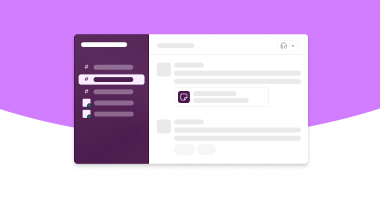The Slack Workforce Lab has been running a series of workshops aimed at helping teams to embrace AI at work. The premise is simple: While AI tools promise incredible productivity gains, many desk workers are still struggling to understand how to integrate them into their day-to-day workflows. Open conversations can help leaders better understand what’s holding their people back from getting the most out of AI.
Creating safe spaces for employees to ask questions, learn, and share blockers is critical. The good news is that these conversations aren’t as daunting as they may seem. Read on for a simple research-backed playbook to engage your team in meaningful dialogue.
Start with the current state: How are people using AI today?
Begin by inviting team members to share how they’re currently using AI in their work. You might be surprised by the range of answers. In our workshops, we found that many people want to use AI more but aren’t sure if they’re “doing it right.” Participants were hungry to hear the specifics of how their colleagues are using AI in the flow of their day-to-day work, and use cases varied significantly from role to role.
Activity:
As a first step, invite your team to take the AI personas quiz — a short (about five minutes) quiz designed to tease out how each person relates to AI tools. Then set aside time to discuss results, inviting participants to share the last thing they used AI for at work. This could be a quick “round the horn” at the beginning of a team meeting or a longer purpose-built “lunch and learn”-type session. The goal is to surface use cases so everyone can learn from one another. You’ll also get clarity on where AI is already adding value and identify any gaps. And because AI technology is rapidly improving and new use cases are emerging all the time, it’s worth continuing to revisit this topic on a monthly or quarterly basis.
Pro tip: Lead by example. Encourage managers and senior team members to share their AI use cases publicly; this could be as simple as sharing a quick clip in a Slack channel. This helps normalize AI usage and inspires others to share.
Acknowledge mixed feelings and tease out boundaries
Workforce Lab research has shown that desk workers have a range of feelings about AI — from interest to concern to guilt to uncertainty. Many of the mixed feelings stem from lack of clarity around AI norms; when is it okay (and not okay) to use AI for work? These are conversations teams should have, but they often don’t, leading to confusion and worry about what’s acceptable.
As a leader, your role is to acknowledge and normalize people’s feelings, clarify permissions and acceptable use cases, and encourage people to experiment and share what they learn.

Activity:
Facilitate a discussion around how your employees really feel about AI. Excited? Skeptical? Neutral? All of the above? We had fun asking people to share a GIF representing the emotion they most often experience when using AI. This got participants laughing, and put them more at ease to be honest with one another about their experience.
Then try a simple polling activity: Ask team members to evaluate whether it’s okay to use AI for specific tasks, such as writing emails or drafting performance reviews. You can use a scale from “completely comfortable” to “uncomfortable.” This will surface a finer understanding of opposing viewpoints and identify where team norms need to be created or clarified.
Identify sticking points and codify team norms
Through our workshops, common themes that came up were a desire for clearer AI guidelines, more clarity on what tools were allowed, and hunger for more training and enablement opportunities. Some of these needs can be met by simply pointing to guidelines your organization has created, while others may require more work at the team level to identify and address points of confusion around specific roles and use cases.
Activity:
Ask your team to reflect on confusion or concerns they have about adopting AI tools, and solicit ideas for what actions would be most helpful to them. You could do this live in a meeting, or asynchronously in a simple Slack thread or virtual whiteboard tool.
Then work to resolve open questions and document and codify the answers in your team-level agreements.
Pro tip: Celebrate experimentation. Make sure to celebrate the process of experimentation, not just the outcomes! Leaders can help by sharing their AI misses, not just their wins, making it clear that even failed attempts with AI can provide valuable insights.
Driving AI adoption requires more than just making tools available, it’s about helping employees to feel supported, confident, and aligned in how they use AI. By opening conversations about AI use, addressing emotions, establishing norms, and fostering a culture of experimentation, you can empower your team in their AI journey.






